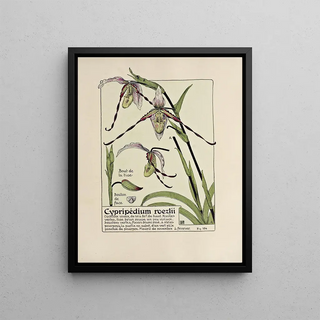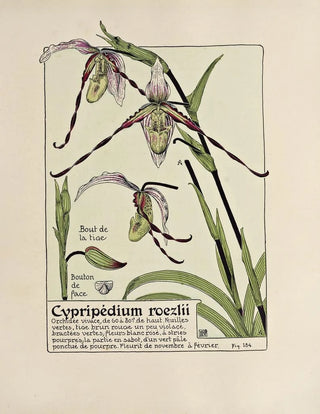Art print | Cypripedium röselii - Maurice Pillard Verneuil


View from behind

Frame (optional)
In the vast panorama of floral art, the work "Cypripedium röselii - Maurice Pillard Verneuil" stands out for its delicacy and refinement. This depiction of a rare orchid, imbued with poetry, invites the viewer to a deep contemplation. The choice of this flower, a symbol of beauty and elegance, reflects an artistic sensitivity that transcends mere decoration to touch the very essence of nature. Immersing oneself in this piece, one feels a connection with the plant world, an invitation to appreciate the intricacy of details and the richness of colors. The art print of this piece becomes much more than a simple object: it is a tribute to the ephemeral beauty that nature offers us.
Style and uniqueness of the work
The uniqueness of "Cypripedium röselii" lies in the technical mastery of the artist, who manages to capture the grace of this orchid with remarkable precision. The subtle nuances of the petals, ranging from cream to delicate pink, are rendered with such finesse that they seem almost tangible. Every curve and vein is carefully accentuated, creating a depth effect that brings the composition to life. This style, both naturalist and ornate, draws from influences of Art Nouveau, where nature is celebrated in all its splendor. Verneuil, through his approach, succeeds in infusing an almost spiritual dimension into his representation, transforming a simple flower into a symbol of harmony and serenity.
The artist and his influence
Maurice Pillard Verneuil, an emblematic figure of his time, established himself as a master of floral decor. His career, marked by an incessant quest for beauty and harmony, led him to explore the limits of decorative art. Verneuil does not merely depict natural elements; he elevates them, reinvents them, transforms them into true works of art. His influence extends well beyond his era, inspiring many contemporary and future artists. By integrating floral motifs into various creations, he paved the way for a new way of perceiving nature, where each element becomes a source

Matte finish

View from behind

Frame (optional)
In the vast panorama of floral art, the work "Cypripedium röselii - Maurice Pillard Verneuil" stands out for its delicacy and refinement. This depiction of a rare orchid, imbued with poetry, invites the viewer to a deep contemplation. The choice of this flower, a symbol of beauty and elegance, reflects an artistic sensitivity that transcends mere decoration to touch the very essence of nature. Immersing oneself in this piece, one feels a connection with the plant world, an invitation to appreciate the intricacy of details and the richness of colors. The art print of this piece becomes much more than a simple object: it is a tribute to the ephemeral beauty that nature offers us.
Style and uniqueness of the work
The uniqueness of "Cypripedium röselii" lies in the technical mastery of the artist, who manages to capture the grace of this orchid with remarkable precision. The subtle nuances of the petals, ranging from cream to delicate pink, are rendered with such finesse that they seem almost tangible. Every curve and vein is carefully accentuated, creating a depth effect that brings the composition to life. This style, both naturalist and ornate, draws from influences of Art Nouveau, where nature is celebrated in all its splendor. Verneuil, through his approach, succeeds in infusing an almost spiritual dimension into his representation, transforming a simple flower into a symbol of harmony and serenity.
The artist and his influence
Maurice Pillard Verneuil, an emblematic figure of his time, established himself as a master of floral decor. His career, marked by an incessant quest for beauty and harmony, led him to explore the limits of decorative art. Verneuil does not merely depict natural elements; he elevates them, reinvents them, transforms them into true works of art. His influence extends well beyond his era, inspiring many contemporary and future artists. By integrating floral motifs into various creations, he paved the way for a new way of perceiving nature, where each element becomes a source






